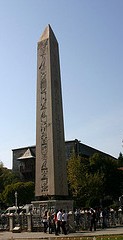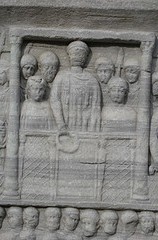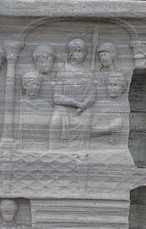

The Hippodrome of Constantinople, known today as Sultanahmet Square (Turkish: Sultanahmet Meydanı) in Istanbul, Turkey, is one of the most significant historical sites in the city. Originally the ceremonial and sporting heart of Byzantine Constantinople, it was a vast public arena where chariot races, political events, and social gatherings shaped the life of the capital. Though much of the original structure is no longer visible, the site retains several iconic monuments and continues to serve as a central public space in modern Istanbul.


The Hippodrome was first established in 203 CE during the reign of
Roman Emperor Septimius Severus, who began developing Byzantium as a
major city. However, it was significantly expanded and transformed under
Constantine the Great after he made Constantinople the capital of the
Roman Empire in 330 CE. Modeled after the Circus Maximus in Rome, the
Hippodrome became the epicenter of public life in the Byzantine Empire,
serving as a venue for chariot races, imperial ceremonies, public
executions, and political demonstrations.
The Hippodrome was
particularly vital during the Byzantine period (4th–15th centuries),
hosting chariot races that were not just sporting events but also major
social and political spectacles. The races were organized by factions
known as the Blues and Greens, which represented different social and
political groups. These factions wielded significant influence, and
their rivalries sometimes erupted into violence, most notably during the
Nika Riots of 532 CE. The riots, sparked by factional tensions, led to
the destruction of much of Constantinople and the deaths of tens of
thousands, with Emperor Justinian I nearly losing his throne before
suppressing the uprising.
After the Ottoman conquest of
Constantinople in 1453 CE, the Hippodrome lost its original function.
The Ottomans referred to the area as At Meydanı ("Horse Square") and
used it for festivals, fairs, and occasional sporting events. Over time,
the site was built over, and its structures were dismantled or buried.
Today, the area is a public square, but several surviving monuments from
the Byzantine era make it a key historical and tourist site.
The Hippodrome was a massive, U-shaped arena designed to accommodate
tens of thousands of spectators. While little of the original structure
remains, historical records and surviving elements provide insight into
its design and layout.
Dimensions and Layout:
The Hippodrome
measured approximately 450 meters long and 130 meters wide, making it
one of the largest arenas of its kind in the ancient world.
It was
oriented north-south, with a U-shaped track for chariot racing and a
central raised platform called the spina, which was adorned with
statues, obelisks, and monuments.
The arena could seat up to 100,000
spectators, with tiered seating (most of which has disappeared) arranged
along the sides and the curved southern end.
At the northern end was
the Kathisma, an imperial box where the emperor and court watched
events, connected directly to the Great Palace of Constantinople.
Spina and Monuments:
The spina was the central barrier dividing
the racetrack, decorated with lavish sculptures, columns, and obelisks,
many of which were brought from across the empire to symbolize
Constantinople’s power.
Three surviving monuments from the spina
remain in situ today, forming the core of the Hippodrome’s historical
legacy (described in detail below).
The spina also featured bronze
statues, such as the Quadriga of Lysippus (a four-horse chariot group),
which was looted during the Fourth Crusade in 1204 and taken to Venice,
where it adorns St. Mark’s Basilica.
Entrances and Surroundings:
The Hippodrome had multiple gates for access, including ceremonial
entrances for the emperor and competitors.
The surrounding area
included palaces, churches, and public buildings, making the Hippodrome
the heart of Constantinople’s civic life.
Construction Materials:
The structure was built using stone, brick, and marble, with the seating
areas likely covered in marble or decorative stone, as was common in
Roman and Byzantine architecture.
The track itself was made of packed
earth or sand to provide traction for chariots.
The surviving monuments in the Hippodrome are among Istanbul’s most
iconic landmarks, each with its own historical and artistic
significance. These are located along the former spina and are the
primary remnants of the Byzantine arena.
Obelisk of Theodosius
(Egyptian Obelisk):
Origin and Date: This red granite obelisk was
originally erected in 1500 BCE by Pharaoh Thutmose III in Egypt, near
the Temple of Karnak. It was transported to Constantinople by Emperor
Theodosius I in 390 CE and erected in the Hippodrome.
Description:
The obelisk stands 19.6 meters tall (originally taller, but the lower
portion was damaged during transport). It is carved with hieroglyphs
celebrating Thutmose III’s victories.
Base: The obelisk rests on a
marble pedestal added by Theodosius, decorated with reliefs depicting
the emperor, his court, and scenes of chariot races. The pedestal also
describes the engineering feat of erecting the obelisk, which took 32
days.
Significance: The obelisk symbolized the continuity of imperial
power, linking Constantinople to the ancient world.
Serpentine
Column:
Origin and Date: This bronze column was created in 479 BCE by
the Greeks to commemorate their victory over the Persians at the Battle
of Plataea. It originally stood at the Oracle of Delphi and was brought
to Constantinople by Constantine the Great in 324 CE.
Description:
The column consists of three intertwined serpents, though the heads are
missing (one fragment is in the Istanbul Archaeological Museum). It
stands about 8 meters tall, though it was originally taller.
Significance: The column represents a trophy of Greek unity and victory,
repurposed to glorify Constantinople. Its weathered appearance reflects
its age and exposure to the elements.
Walled Obelisk
(Constantine’s Obelisk):
Origin and Date: This stone obelisk was
likely built or restored in the 10th century CE during the reign of
Emperor Constantine VII Porphyrogenitus, though its exact origins are
debated.
Description: The obelisk is 32 meters tall and made of
roughly hewn stone blocks, originally clad in bronze plates inscribed
with victory dedications. The plates were looted during the Fourth
Crusade.
Significance: Though less ornate than the other monuments,
it served as a marker of Byzantine imperial prestige and continuity.
The Hippodrome was far more than a racetrack; it was a stage for
Byzantine society and politics:
Chariot Racing and Factionalism:
Chariot races were the most popular entertainment in Constantinople,
akin to modern sports spectacles. The Blues and Greens, supported by
different social classes and political factions, turned races into proxy
battles for influence. The emperor often aligned with one faction,
making the Hippodrome a barometer of public sentiment.
Political
Arena: The Hippodrome was where emperors addressed the public,
distributed largesse, or faced protests. It was a space for dialogue—and
sometimes confrontation—between rulers and citizens, as seen during the
Nika Riots.
Symbol of Power: The spina’s monuments, drawn from Egypt,
Greece, and Rome, showcased Constantinople’s role as the "New Rome" and
heir to ancient civilizations.
Cultural Legacy: The Hippodrome
influenced later public spaces in the Islamic and European worlds, with
its model of a grand civic arena enduring in various forms.
Today, the Hippodrome is no longer a distinct structure but a public
square known as Sultanahmet Square, located in Istanbul’s historic
district near the Hagia Sophia and Blue Mosque. Its modern status
includes:
Preservation and Appearance:
The original U-shaped
track and seating are buried or built over, but the alignment of the
square follows the Hippodrome’s footprint. Archaeological excavations
have revealed portions of the foundations, visible in nearby museums or
underground.
The three spina monuments (Obelisk of Theodosius,
Serpentine Column, and Walled Obelisk) remain in their original
positions, forming a historical spine through the square.
The area is
landscaped with pathways, lawns, and benches, making it a popular
gathering place for locals and tourists.
Tourist Attraction:
Sultanahmet Square is a UNESCO World Heritage Site (as part of
Istanbul’s historic areas), drawing millions of visitors annually for
its historical significance and proximity to other landmarks.
Informational plaques near the monuments provide context, and guided
tours often include the Hippodrome as part of broader Byzantine and
Ottoman itineraries.
The square is free to visit, though nearby
museums (e.g., Istanbul Archaeological Museum) charge admission for
related artifacts.
Cultural Events:
The square hosts
festivals, concerts, and public celebrations, especially during Ramadan
and national holidays, echoing its historical role as a communal space.
The annual Istanbul Marathon and other events sometimes pass through or
start in the square, connecting it to modern sporting traditions.
Challenges:
Heavy tourism and urban activity strain the site’s
preservation, with the monuments exposed to pollution and weathering.
Ongoing archaeological work seeks to uncover more of the Hippodrome’s
remains, but Istanbul’s dense urban fabric limits large-scale
excavations.
Nika Riots: During the 532 CE riots, the mob proclaimed a rival
emperor in the Hippodrome, and Justinian’s brutal response (killing
30,000–40,000 people) cemented his authority but left a dark legacy.
Lost Treasures: The Fourth Crusade (1204) saw Crusaders loot many of the
Hippodrome’s bronze statues, including the Quadriga, which was melted
down or repurposed in Western Europe.
Sphendone: The curved southern
end of the Hippodrome, known as the Sphendone, partially survives and
can be seen in the Marmara University area, offering a glimpse of the
original structure.
Modern Rediscovery: In the 19th and 20th
centuries, European scholars and Ottoman authorities began studying the
Hippodrome, leading to its recognition as a key Byzantine site.